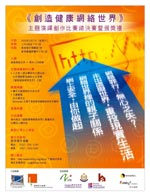|
Recruitment
of the 2nd Batch of McCafe baristas
Based
on the successful co-operation with McDonald' s in the
1st
"McCafe Coffee Professionals Scheme" last July,
the Federation is now launching the 2nd training scheme with
McDonald's, together with the full support
of Labour
Department - The Youth Work Experience and Training Scheme. Ten
baristas are being recruited for pre-employment training.
The programme
offers a valuable opportunity to young people who have a
passion for brewing and serving a delicious cup of coffee
to discerning Hong Kong consumers. Successful candidates
will have a 6-month job placement at branches of McCafe
from February to July 2005 and will learn the skills of coffee
making, restaurant operations and customer service techniques.
Read more about it at:
www.yen.org.hk/yptp/plan_b.htm
|
 |
|

LEAD
Project launched
On
2 February 2005, the LEAD (Leading through Engineering,
Art and Design) Pilot Project was launched with a Seminar
on Creative Learning at the Conference Center at Pacific
Place One. This marks the beginning of a significant collaboration
between the Federation, the MIT Media Laboratory and The
Chinese University of Hong Kong. The seminar was
attended by about 250 school principals, teachers, youth
workers
and representatives from the commercial and industrial
sector. LEAD receives the generous sponsorship of the Innovation
and Technology Fund, Hang Fung Gold Technology
Group, May Cheong Toy Products Factory Ltd., Mr. Edward
Cheng and
Dr. Patrick Wang. It will
run for a 5-month trial period and consist of workshops
for students under the guidance of trained facilitators.
They will do project work involving mechanics, engineering
design, computation, robotics, animation, art and film
sciences to enhance their creativity through digital creative
learning. Visit http://www.u21.org.hk/lead/ for
more information.
|
 |
|
| |
|
 |

Creativity:
the LEAD Pilot Project
Creative
education relies on letting children explore their world,
experiment freely and express themselves through hands
on experience with the objects that surround them. Increasingly
that means coming to grips with technology. Kids love it,
especially when it allows them to solve problems with computers,
construct their own digital games and create robotic toys.
Through
the Pilot Project for LEAD ( the acronym for Leading through
Engineering, Art and Design ) that the Federation launched
this week with partners from the Chinese University of Hong
Kong and the MIT Media Laboratory, children will be brought
into this world of inventive digital creativity.
|
|
Encouraged
to learn and innovate through projects involving mechanics, engineering,
robotics, interactive art and film, they will learn core digital
skills using MIT Media Lab software which lead onto higher level
skills involving the design process, problem solving, teamwork
and the feedback cycle.
The fundamental
message in this learning process is innovative, creative thinking,
made possible via a free environment reserved only for play
in more traditional education. This meeting ground stimulates
communication in a world where technology has given us the
joy of instant contact. The LEAD project will give children
the confidence to use digital creativity to understand the
world in which they live and to communicate their ideas to
others. Once they feel completely confident with this technology
they will have the functional but flexible skills to succeed
and prosper in the workforce of tomorrow.
Kung
Hei Fat Choi to all our readers,
May you have a happy and prosperous Year
of the Rooster

|

Creativity,
responsibility and the Cyberworld
Young people these days are very aware of the problems and the
joys of the Internet, as an article in this issue's Facts & Figures
shows. Students who have taken part in the Federation's Creating
a Healthy Cyberworld programme have demonstrated their grasp
of the issues by creating videos and computer animations that
air these problems. One of those young creators is Kitty, now
in Form 5 at Belilios Public School. She told us how she got
the idea for her story and about the process of turning that
idea into reality.
I
saw that computers can cause problems for some families. My brother
and I are always playing with ours. I thought it would be a good
idea to create an animation to show people what can go wrong
and why.
Kitty used
Flash software to create her graphics. She has computer monitors
with mobile
human expressions that talk about the problem
of illegal downloading of music and Internet fraud known as "phishing".
It was clear that Kitty' s grasp of the ethical and legal issues
was unequivocal even though she was well aware of the temptations.
As a result her animation sends a very clear message.
But it wasn't
all plain sailing and there were times when she wasn't so confident
in
the results. But she persevered. When she
had technical hitches, she talked them over with her brother and
they solved the problem as a team. Now and then she asked her teacher,
who had asked for volunteers for the Federation's Cyberworld competition,
but she managed mostly on her own, by experimenting, at home, with
the encouragement of her mother.
It was fun, just like playing, but at the same time I actually
made something useful with the computer. That was very satisfying
and in the end I was happy to be able to present the result at
the competition.
Kitty was growing
up at a time when computers were common enough, even at her primary
school where she first used one. She's totally at home with
them now and chose the elective in computer studies at her secondary
school. Now she's preparing for the public examinations and
20% of the marks for this course go on project work. She chose
to make an e-book which teaches people how to use Flash. Kitty
says:
Taking part in the Cyberworld competition and making my first
animation really helped when it came to working on a computer project
at school. It gave me the confidence to try something new with
the technical skills I had learned.
At the Federation
we are delighted and proud to have been able to help Kitty, a
physically challenged 16year-old, succeed in the
challenge of creating an innovative, instructive video using animated
computer graphics. She has managed to make the medium convey its
own message on the complex topic of digital crime. Her next project?
Something a bit more light-hearted she says - probably a computer
game.
Bravo Kitty. More Federation programmes of a similar nature can
do nothing but bring out the best in talented children. With the
launching of the LEAD project this month we can hope that similar
dormant talent in young people will be stimulated into life and
brought to the same kind of fruition.
|



Kitty's animation
interface |
 |
 |
|
First year, female, bright and depressed
A University
of Hong Kong web-based survey released last month revealed that
over 20% of all first year tertiary students in Hong Kong are
depressed, 41% felt anxious and 26.5% felt the effects of stress.
Among the 8000 students polled at 10 institutions of further education,
the female to male ratio of sufferers is 63% to 37% and those with
top school grades studying law or medicine are the worst off.
Similar figures
have come out of the US where again the incidence of depression
among 1st year college freshmen is more common than
among the general public and within that group the same ratio, female
to male, occurs. In the UK 63% of universities reported an increase
in
psychological distress among students during the 1990s. Other telling
figures show that 1 in every 500 women between the ages of 15 and
25 requires extensive treatment for anorexia, an anxiety disorder
often linked with depression, the incidence of which has also been
linked with high academic achievement.
Studying at university
no longer means the pursuit of knowledge for its own sake and where
vocational studies are concerned, those
who want to be high-flyers on top salaries feel stress much more
keenly because of the competition, especially if they are females
competing in a male-dominated environment. What young people need
to balance the stress they feel is mental space, time to be creative
and have fun. HKFYG programmes like LEAD, described elsewhere
in this issue, are all about guided creativity. Our hope is that
they can help young people create for themselves the vital balance
needed for well being and equilibrium.
|

|
 |
|
Fighting
pirates
The
abuse of intellectual property is a flourishing business and
there are many culprits, not only
the producers - many of whom operate on the Mainland - but also
on the streets of Hong Kong where there are still numerous peddlers
despite Customs crackdowns. At home there are other forms
of piracy, especially tempting for young people.
The Intellectual Property Department commissioned a poll survey
of 1214 people last November. Only 10% actually admitted to regular
downloading of movies, e-books, music and shared files even though
95% of the same sample group thought it necessary to protect intellectual
property rights. The real figure for Internet piracy at home is
probably a lot higher than 10% and the majority of the self-confessed
illegal downloaders are under 30, most being either secondary school
or university students. The Department is investing HK$700 million
this year promoting educational and publicity programmes intended
to raise the awareness of young people about the laws and ethics
of copyright.
Things have
improved since the 1990s, when there were at least 1000 pirate
copy stalls
all over the city but there is no control
over person-to-person sharing of songs and films. The music industry
is trying to counter illegal downloading by creating legal, inexpensive
fee-paying sites, where you can download your favourite Canto-pop
hit for as little as HK$8. Meantime some of our top performers
see their sales plummeting - a sure ingredient for plummeting
creativity.
The Federation's
Youth Exchange Unit holds conferences, competitions and exchange
camps
with the theme of Creating a Healthy Cyberworld.
The problems of copyright over digital material naturally come
within the ambit of our concern and we have interviewed the producer
of the winning video of the 2003 competition who dealt with the
subject in an innovative manner. See Lead Story above for details.
|

|
 |
|
Giving
generously: a young person's view of lai see
According to
a recent survey about half of those aged from 15-34 will spend
an average of $2,370 in the shops during the coming Lunar New
Year Holidays. Where do they get all that the spare cash? In
their lai see packets perhaps. Total spending on lai see by the
same age group is estimated to be over $2,900 per person says
the survey. However, only 7% of all age groups said they would
put at least $50 in each packet whereas 70% reckoned on
just $20 per packet. That's an awful lot of packets isn't it
- between 58 and 145 per person to be precise. No wonder the
red packet vendors are doing such a roaring trade!
|
|
 |
|
|

